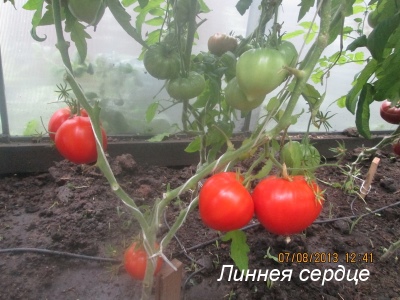
- Authors: USA
- Name synonyms: Linnaeus heart
- Category: grade
- Growth type: semi-determinant
- Appointment: fresh consumption, for juice
- Ripening period: mid-early
- Ripening time, days: 90-110
- Growing conditions: for open ground, for greenhouses
- Bush size: medium-sized
- Bush height, cm: 150
The name of the variety in honor of the famous natural scientist is a lot of obligations. But this does not mean that farmers can ignore the study of such a crop and plant it as they please. On the contrary, only with a careful study of the characteristics of the plant can success be achieved.
Description of the variety
This tomato is of American origin and has an alternative name, Linnaeus heart. Bushes of medium height (maximum 1.5 m). The tomato is suitable both for an open garden and for growing in a greenhouse. Leaves of the usual type also develop on an ordinary stem. An important characteristic feature is the semi-determinant course of development.
The main qualities of the fruit
Ripe berries of the Heart of Linnaeus are red in color. They grow to a large size. The usual mass of such tomatoes is 0.3-0.4 kg. Geometrically, they are closest to the stereotypical heart. There are no more special subtleties here.
Taste characteristics
The flesh of Linnaeus's Heart is fleshy. Inside it, there are almost no seeds, and therefore they cannot influence the taste. In general, the berry is perceived very well and is liked by almost all consumers.
Ripening and fruiting
Linnaeus's heart belongs to the remarkable mid-early tomato group. Under normal developmental conditions, it takes 90-110 days from discarding green shoots to the appearance of edible berries. Such a significant difference in the timing of development only emphasizes the relevance of both weather and agricultural technology. The tomato bears fruit for a long time. They can be collected in July and August.
Yield
The declared level of productivity is from 8 to 12 kg per 1 sq. m. Much will depend on the diligence and accuracy of the farmers.
The timing of planting seedlings and planting in the ground
Sowing seeds in containers is usually carried out in the last third of February. But you can do this in the first decade of March. For planting seedlings, a productive garden sod is used.

Growing tomato seedlings is an extremely important process, because it largely depends on whether the gardener will be able to harvest at all. All aspects must be taken into account, from seedbed preparation to planting in the ground.
Landing scheme
The most rational planting system is 400x400 mm. It is this that the seed supplier directly recommends. There is no indignation at such a seedling rule. For 1 sq. m planted 4 or 5 bushes.

Growing and care
The bushes must be shaped. Another important requirement is keeping the plants in 1, 2 or 3 stems. The choice between these options must be made with basic horticultural considerations in mind. Seedlings are supposed to be fed with the "Krepysh" preparation.Do this 2-3 times during the growing of seedlings.
A pick on the containers is made when the 2nd true sheet appears. Instead of watering from a bottle or watering can, the seedlings need to be irrigated with a spray bottle. Formation is carried out in 2 barrels. Top dressing in the ground is carried out at the stage of flowering and ripening of fruits. Mulching the planting, as well as airing them (for greenhouse cultivation) is absolutely necessary.
There is less information on planting, cultivation and care for this particular variety than it should be. Therefore, one has to often be guided by considerations of a general character for medium-early tomatoes. It must be remembered that such a plant requires pollination by bees. Therefore, they must be admitted to the same greenhouses at least periodically. Important recommendations:
light up the seedlings so that they develop at an accelerated rate;
maintain the optimal thermal regime for the development of seedlings;
control humidity for both seedlings and adult bushes;
be sure to resort to watering when the soil dries out;
strictly observe the norms of crop rotation;
avoid excessive moisture;
increase the intensity of sunlight;
properly loosen and fertilize the soil before planting;
prepare the soil in the greenhouse in the fall.




A plant needs different micronutrients at each stage of growth. All fertilizers can be divided into two groups: mineral and organic. Folk remedies are often used: iodine, yeast, bird droppings, eggshells.
It is important to observe the rate and period of feeding. This also applies to folk remedies and organic fertilizers.



























































































